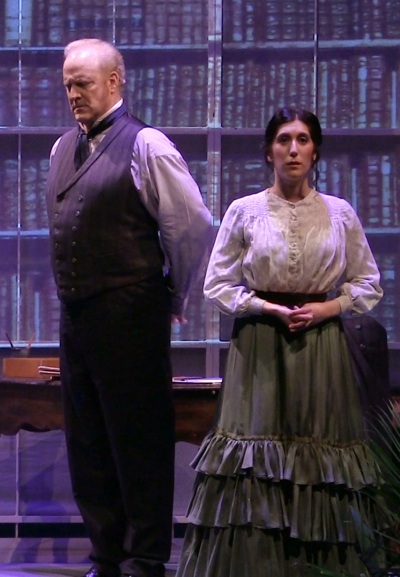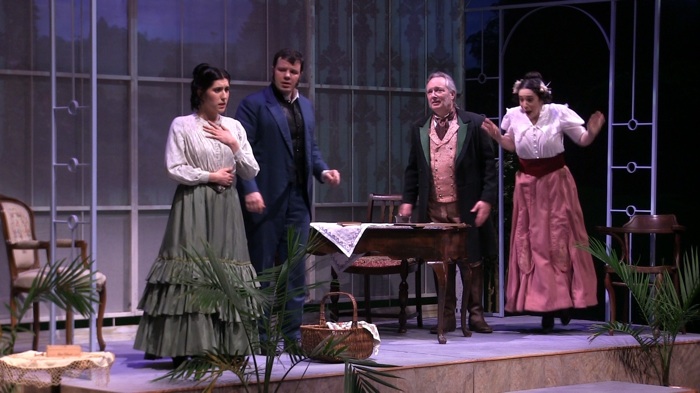Rediscovering an English enchantment
Having trespassed on the shores of musicology whilst eschewing any regard for the Great Works of Literature, I really thought I could skim Middlemarch the night before the premiere of Allen Shearer’s Middlemarch in Spring, an opera based on that 19th century edifice of English fiction.
After wading through the first several pages of a “pocket” book that clocked in at 1,026 pages, I turned to the back cover for inspiration. “A book that can be read, and reread,” claimed a pull-quote. And so I read and re-read those first pages, hoping for a glimpse of where we were being steered.
 Curiously, once one’s ear is tuned to the meanders and cadences of author George Eliot, the nom de plume of Mary Ann Evans, one can hear sly observations on social status and human behavior amidst a sea of young passions, and I am reliably told that it develops a powerful grip, distant kin to the people-watching tabloids of our own day.
Curiously, once one’s ear is tuned to the meanders and cadences of author George Eliot, the nom de plume of Mary Ann Evans, one can hear sly observations on social status and human behavior amidst a sea of young passions, and I am reliably told that it develops a powerful grip, distant kin to the people-watching tabloids of our own day.
The husband-and-wife team of composer Allen Shearer and librettist Claudia Stevens has already produced The Dawn Makers and The Very Large Mole to acclaim, and their huge new undertaking was four years in the making. Last Friday night, March 20, San Francisco’s Z Space was transformed into an airy English garden inhabited with six fine singers and propelled by 11 musicians led by conductor Jonathan Khuner. The action, though refined, was gripping, made easily accessible through Stevens’ reduction and the singers’ careful diction.
The music was a revelation, from nuance to bite and even to storm. After a mild spring-like introduction, woodwinds warbled the end of sung phrases like tiny exclamation points, or burst into rising flute notes as quirky questions. These top musicians (and they included four members of the chamber group Earplay among them) anticipated the action in atmospheric interludes, and then exposed the vocals in sea-like surges, rhythmic “crypticisms” that mirrored and explored the emotional dynamics.
And those dynamics? The rumors and rules of small-town life, the bonds of family, the rigidity of the social system, the constraints on women, and, above all, unwise love.
The duets were also explorations of those human dynamics: at times voices crossed like swords, and at other times there was a sweetness to the exchange, where one finishes the thoughts of another. Or they blurred into that large terrain between war and love, starting together and ending with separate texts. It was a rich device, and as colorful and coy as the nineteenth century original.
Besides those rewarding duets were trios and even a final sextet of the dead and the living, powerful in the cozy theater.
Soprano Sara Duchovnay exposed the complex character of the winningly idealistic heroine, Dorothea: “Oh Beauty, truth…show me the way!” she implored, creating intimacy even in the extremes of her range – and there was one moment when she realized that her husband was dead and spilled from high cries down to devastatingly low wails.
That husband, the odious Casaubon, was played with perfect pomposity by bass-baritone Philip Skinner, along with devastating and careless put-downs of his young bride. “There is a lightness to the feminine mind,” he mused. “Like a butterfly.” His fine acting was evident as a nefarious Scarpia with West Bay Opera and an acclaimed Iago with Festival Opera. And here Skinner embodied the sins of self-absorption and indifference in a resonant voice that ranged from the gravel of dull anger to high notes of wounded pride.
Tenor Daniel Curran was the young suitor whose dreams of an ideal society and of political reform ultimately won Dorothea’s heart. The urgency of his message was the more potent for the youthful purity of his voice, an instrument of great color and soft edges. Eugene Brancoveanu added his own lustrous baritone to the character of Sir James Chettam, another complex character that Brancoveanu happily develops. After being rejected by Dorothea, he wed her sister, Celia, while remaining attentive to our heroine (yes, they liked to keep things in the family back then).
Tonia D’Amelio was a delightful Celia, balancing her love of her sister with an eye to realism, and all impelled by a lovely soprano that was as seductive as it was decorative. “She paints the world in colors no one else can see,” she sang of her sister.
Michael Mendelsohn, whose mellow tenor augmented his spot-on characterization of a benevolent uncle with old-fashioned ideas on the social order, filled out the cast. “Think of the beehive. Each in its place,” he ruminated.
In fact, they were all so fine that I wondered why it was not more moving. Was that English sensibility a stretch? Was the social stratification a complete turn-off? Or was it just too darn accessible?
I realized that I missed Eliot’s gorgeous language and subtlety, the underpinnings of the drama.
In Chapter 20 she wrote, “If we had a keen vision and feeling of all ordinary human life, it would be like hearing the grass grow and the squirrel’s heart beat, and we shall die of that roar which lies on the other side of silence.”
I’m hooked on the original.
—Adam Broner
Photo top of Philip Skinner and Sara Duchovnay; below of Duchovnay, Eugene Brancoveanu, Michael Mendelsohn and Tonia d’Amelio. Both photos by Jeremy Knight.

